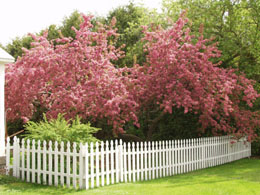The pink flush of flowers on your crabapple will leave you with beautiful memories to come. The following passages give more information on growing this beautiful tree.

New York city spring visitors will always have a photograph of the city's parks that are full of scented blooms of the crabapple tree. It is native to the Northern Hemisphere, especially to the temperate regions of Europe, Asia, and North America. It is a genus of 35 natural species and over 500 cultivated species of small deciduous trees or shrubs in the family Rosaceae. Its scientific name is
Malus. The other species are also known as wild apples or crabs.
About Crabapples
One of the popular flowering trees, crabapples can be grown as small trees or shrubs. Their height ranges between 6 to 50 feet and their spread is dense. Depending upon the variety grown, they can have a weeping, spreading, or a pyramidal-shaped crown. Its fruits and leaves are mostly insignificant as the fruits are extremely sour and leaves not very showy. The fruits are used more for their juice extraction. The leaves are pale green, 3 - 10 cm long, and alternately arranged with a serrated margin. Their flowers make them ideal for landscaping. Their five-petaled white, pink, or red blossoms that bloom every spring in clusters cover up the entire tree. Depending upon the different varieties of this tree, the flowers may be single, semi-double, and double. If it is the flowers that interest you, opt for a double petaled one, as they don't bear good fruiting.
Opt from popular varieties, like Siberian, Japanese flowering, Sargent crabapple, etc. The tree does very well in rich, loamy, well-drained soil and full sun. The soil should be enriched with organic matter. Avoid fertilizing the first year. Water it well during its establishment period. Post that, water as per climatic need. In fact, if your soil is well drained, then water it appropriately during droughts every two weeks. Fertilize with a nitrogen-phosphorus-potassium based fertilizer just before the onset of bloom.
Pruning
There are no hard and fast rules to pruning a crabapple. However, if done incorrectly it will damage the next year's flower show. It should be pruned when young to build a strong structure and to shape it. It shoots new sprouts or suckers from the ground quite rapidly. To keep it in shape and also to ensure that the new suckers do not eat away all the nutrients, remove all the suckers in time. Prune before spring or after the flowering season is over. If the tree has gotten too dense, prune the center to facilitate sunlight and ventilation. Never prune in July, as flower buds for the next season begin to appear in July. Prune all dead, diseased, and damaged branches. It is important to cross prune the branches, as fully bloomed ones become heavily laded which leads to breakage.
Diseases
This tree is quite prone to diseases. Although its cultivated varieties are resistant to pest and diseases, they still do have varying degrees of susceptibility to diseases. Fire blight, leaf spot, and apple scab are diseases which can cause a significant amount of damage. Fire blight is a bacterium that turns the branches black, and apple scab is a fungus that leaves black sooty spots on leaves and fruits, eventually killing the tree. Leaf spot and powdery mildew are other diseases that infect it. Specific insecticides and germicides are available for specific problems, but they must be used in time.
Crabapple trees are relatively easy to grow, and with plenty of blossoms it will attract the best pollinating insects. So, go ahead plant this beauty and enjoy the spring time.






 New York city spring visitors will always have a photograph of the city's parks that are full of scented blooms of the crabapple tree. It is native to the Northern Hemisphere, especially to the temperate regions of Europe, Asia, and North America. It is a genus of 35 natural species and over 500 cultivated species of small deciduous trees or shrubs in the family Rosaceae. Its scientific name is Malus. The other species are also known as wild apples or crabs.
New York city spring visitors will always have a photograph of the city's parks that are full of scented blooms of the crabapple tree. It is native to the Northern Hemisphere, especially to the temperate regions of Europe, Asia, and North America. It is a genus of 35 natural species and over 500 cultivated species of small deciduous trees or shrubs in the family Rosaceae. Its scientific name is Malus. The other species are also known as wild apples or crabs.